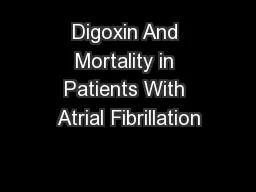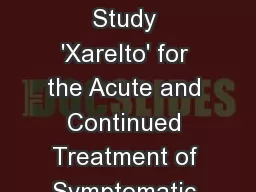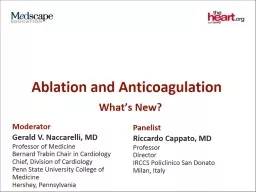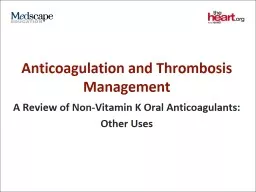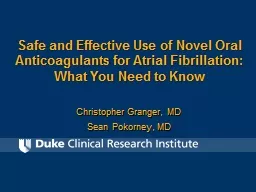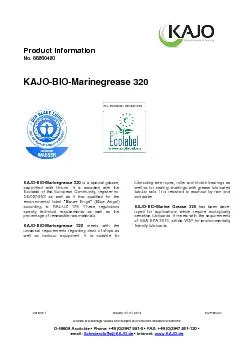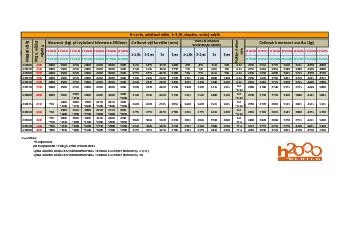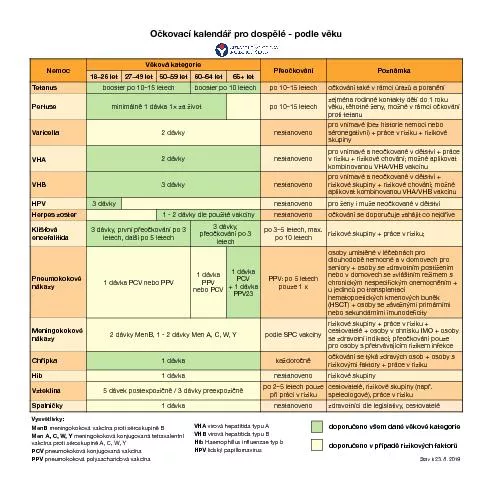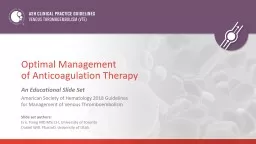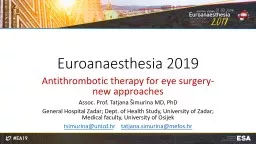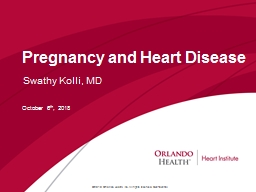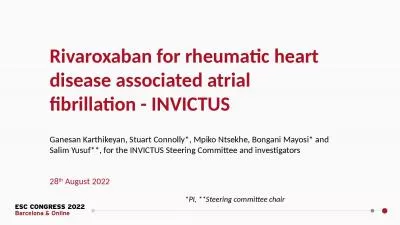PPT-Apixaban vs VKA and
Author : cheryl-pisano | Published Date : 2019-11-07
Apixaban vs VKA and Aspirin vs Placebo in Patients with Atrial Fibrillation and ACSPCI The AUGUSTUS Trial Renato D Lopes MD PhD on behalf of the AUGUSTUS Investigators
Presentation Embed Code
Download Presentation
Download Presentation The PPT/PDF document "Apixaban vs VKA and" is the property of its rightful owner. Permission is granted to download and print the materials on this website for personal, non-commercial use only, and to display it on your personal computer provided you do not modify the materials and that you retain all copyright notices contained in the materials. By downloading content from our website, you accept the terms of this agreement.
Apixaban vs VKA and: Transcript
Apixaban vs VKA and Aspirin vs Placebo in Patients with Atrial Fibrillation and ACSPCI The AUGUSTUS Trial Renato D Lopes MD PhD on behalf of the AUGUSTUS Investigators Background The optimal antithrombotic regimen for patients with atrial fibrillation AF who have an acute coronary syndrome ACS or require percutaneous coronary intervention PCI is unclear. G. . Turpie. Professor Emeritus of Medicine. McMaster University. Hamilton ON. Canada. Future Challenges. Disclosures for Dr A.G.G. Turpie. Research Support. None. Employee. None. Consultant and/or Honoraria. Renato D. Lopes, MD, . PhD, FACC. on behalf of the ARISTOTLE Investigators. Disclosures. The . ARISTOTLE trial was sponsored by Bristol-Myers Squibb and Pfizer.. The present analysis was . sponsored by . Effective PE Treatment Matters. PE is a potentially fatal consequence of DVT. PE is frequently . asymptomatic, and along with DVT, is associated with delayed diagnosis, making prompt treatment difficult. Risks of AF Ablation Procedure. Many Moving Parts . Uninterrupted vs Minimally Interrupted Anticoagulation. Uninterrupted Dabigatran vs Warfarin. DAPPARAF. Dabigatran Ablation Study. RE-CIRCUIT. Multicenter Prospective Study of Uninterrupted Rivaroxaban vs Warfarin. Anticoagulation and Thrombosis Management A Review of Non-Vitamin K Oral Anticoagulants: Other Uses Dabigatran Rivaroxaban Apixaban Edoxaban Target IIa (thrombin) Xa Xa Xa Hours to maximum concentration Christopher Granger, . MD. Sean Pokorney, MD. . Disclosure (Dr. Granger). Research contracts: AstraZeneca, Daiichi, Bayer, Novartis, GSK, Sanofi-Aventis, BMS, Pfizer, Medtronic Foundation, The Medicines Company, and Boehringer . V ersion 1 issued : 21.0 1.2019 MJ/Pos/AO - related fluctuations . D - 59609 Anröchte • Phone: +49 (0)2947 881 - - 120 • email: Schmierstoffe@KAJO.de • Internet: www.KAJO.de Produc t info H - VD25 H - VD30 H - VD35 H - VD10 H - VD15 H - VD18 H - VD20 H - VD20 H - VD25 H - VD30 H - VD35 l v n VD10 H - VD15 H - VD18 3 d An Educational Slide Set . American Society of Hematology 2018 Guidelines . for Management of Venous Thromboembolism. Slide set authors: . E. ric. Tseng MD . MScCH. , University of Toronto. Daniel Witt PharmD, University of Utah. surgery. -. . new . approaches. Assoc. . Prof. Tatjana Šimurina MD, . PhD. General . Hospital Zadar; Dept. of Health Study, University of Zadar; . Medical . faculty, University of Osijek . tsimurina@unizd.h. optic nerve back of eye front of eye pressure build up 1XywdksekXywdksek vka[k dk ,d jksx gksrk gS ftlls n`f”V dh gkfu ;k va/krk gks Xywdksek ds izdkjXywdksek ds nks eq[; izdkj gSa% vksiu&,axy Xy October 6. th. , 2018. Swathy. . Kolli. , MD. Epidemiology. Epidemiology. Spectrum of CVD in pregnancy is changing and differs between countries. Risk of CVD in pregnancy has increased due to increasing age at first pregnancy . Mpiko. . Ntsekhe. , Bongani . Mayosi. * and Salim Yusuf**, for the INVICTUS Steering Committee and investigators. Rivaroxaban for rheumatic heart disease associated atrial fibrillation - INVICTUS. *PI, **Steering committee chair.
Download Document
Here is the link to download the presentation.
"Apixaban vs VKA and"The content belongs to its owner. You may download and print it for personal use, without modification, and keep all copyright notices. By downloading, you agree to these terms.
Related Documents


